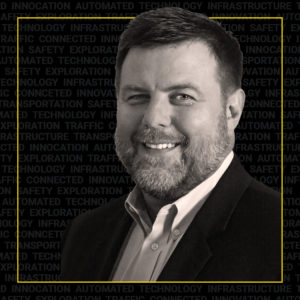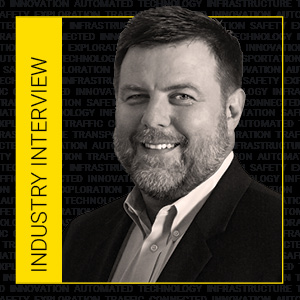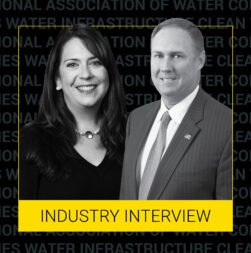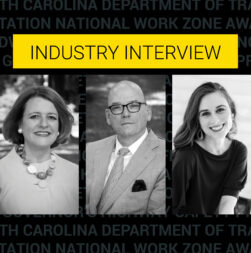Tom Timcho has technical expertise that spans all aspects of intelligent transportation systems and connected vehicle environments. With over 25 years of engineering experience, he currently works with connected and automated vehicle deployment as part of emerging Smart City initiatives for WSP, a global professional firm that provides technical and strategic consultation in transportation & infrastructure, property & buildings, environment, industry, resources (including mining and oil & gas), and energy sectors.
Flagger Force: What do you think are the big trends in transportation to watch right now?

Tom Timcho: The flavor of the day is vehicle automation. But it’s about fully autonomous vehicles (AVs). At this point, we’re exploring different levels of automation. We are already seeing driver safety features in vehicles today that use technology
sensors. For example, emergency automated braking is a form of automation. Related to that is the concept of connectivity. Providing information to drivers or vehicles can help them make informed decisions—that’s connected vehicles (CVs.) And they’re not necessarily tied to one another directly. These are two side-by-side technologies in many respects.
There’s been a fairly large public and private investment in the United States in both of these technologies. WSP is working on connected technologies in Ohio, in particular in the city of Marysville, as part of the 33 Smart Mobility Corridor, which is an investment by various stakeholders at a local and federal level to build a connected vehicle network to allow for testing of new technologies to improve safety and congestion.
Some things have shifted because of the coronavirus (COVID-19). Columbus is rereleasing their automated vehicle shuttle, but instead of focusing on taking people to resources, it’s taking resources to people. For example, automated vehicles are helping move COVID-19 test kits around. Another important trend to watch is the method of data transmission, specifically, the technology. In our work, we’ve been providing our data through a wireless technology that isn’t dependent on a data carrier, as most systems today are reliant upon. It’s vehicle-to-infrastructure or infrastructure-to-vehicle transmissions over a larger network of communication.
Flagger Force: How will connected vehicles work in the future?
Tom Timcho: I think that there’s going to be a convergence of technology, and eventually, a yet-unknown approach will be adopted. People often refer to this question as the old “will it be VHS or Betamax” debate. But as we know both models were completely disrupted, and the answer turned out to be “Netflix.” We don’t know if vehicles will be connected or automated, or if the models will be turned upside down again. It’s hard to say what connectivity will mean in five or ten years. It’s just that right now, we have a VHS-Betamax type of debate going on as to which technology is going to prevail. But I firmly believe that something else is going to come along, and it’s going to disrupt everything. I just don’t know what that is yet.
Flagger Force: There is a lot of speculation about smartphones and vehicles talking to each other. Will this form of connectivity become more common?
Tom Timcho: Vehicle connectivity is based on direct, short-range, low-latency communications. Smartphones instead are dependent on a consumer wireless network that wasn’t designed for the demands required for safety. There is a non-consumer network being deployed for first responders that has safety uses, but we’re not there yet to use cellular networks to enhance the imminent safety of vehicles. Until smartphones and vehicles use the same device-to-device technology, connectivity will likely be limited.
The second challenge with automation and connectivity is the reliability of positioning. If the system can’t detect where a car or cyclist or person is located, within feet, many of the envisioned safety applications are going to be constrained. Reliable location data is going to help systems adjust for safety, for efficiency, for program management, and so on. Managed lanes and congestion-based pricing are already exploring ways to use location data. Smartphones play a part in that as well. Smartphone connectivity could help us in the mobility and efficiency of our roadways. We all know by now that we’re not going to just build our way out of congestion, but data and ideas like managed lanes might help, and smartphones and reliable location data can really move those types of ideas along.
Flagger Force: How close are we to autonomous vehicles?
Tom Timcho: A lot of different surveys and feedback on public perception were compiled recently, and the results show that just convincing people to ride in a fully-automated vehicle is a heavy lift. Consumer education and confidence need to shift. But there also needs to be some level setting on where we are. Do you want to back out of your garage autonomously? Yes! Do you want to drive, fully automated, all the way to your workplace? No way. I think that the vision of all these automated driverless vehicles running around is a dream…for now.
And there are places where we are very far from any sort of AVs or even CVs. In rural areas, automation has some of the best opportunities to impact people’s lives because they don’t have regular transit service, but how long is it going to take to get this technology and the associated infrastructure to those types of areas? And there are lots of dead spots, which prevents reliable connectivity.
Flagger Force: How will these technologies affect traffic safety and traffic management?
Tom Timcho: Eventually, there will be a change in how traffic signaling is modeled. The models we have now were intended to maximize the traffic flow through red lights based on demand, and things like that. In the future, timing and connected vehicles will be a real consideration. And what happens when there is a dark intersection where you’ve got somebody out there, a police officer, trying to signal or wave traffic through? Or what happens at the old four-way stop when somebody at the stop waves you through? These types of things have to be worked out.
Contact Us
Want to collaborate with us? Have a content idea? Reach out—we look forward to partnering with you to keep our communities moving.



